Why is Vajravarahi Practice so Powerful? Vajravarahi Vajrayogini Practice and Mantra: Practicing Buddhist Wisdom and Method Without Renouncing the Worldly
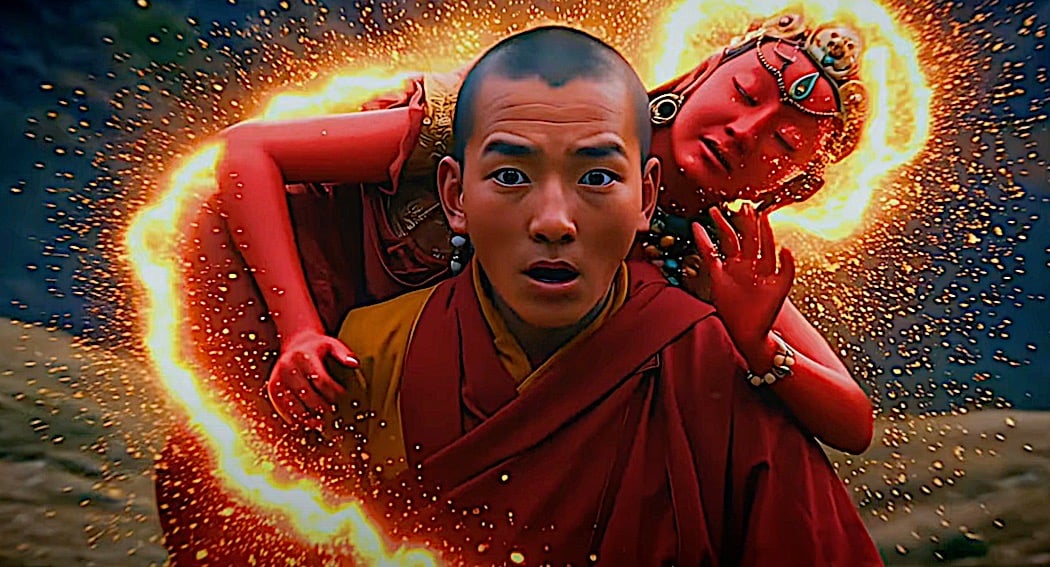
Vajravarahi, Queen of Dakinis, also known as Vajrayogini, is the Enlightened Wisdom of all the Buddhas, applied in daily life as activity. It is for this reason, Vajrayogini practices are so popular today. How can her practice be both the deepest and most profound of practices, but also the most approachable? We answer this question in this short Buddha Weekly feature (or alternate video format embedded below), and end with the beautifully chanted mantra of Vajravarahi 27 times. For the full 8 lines praise, see the linked video on the 3 Gems Band channel, also embedded below!
The great Lama Yeshe described Vajrayogini as the ultimate method for modern daily life:
“The Vajrayogini yoga method is extremely powerful. It is just what we need in these degenerate times, with our delusions running rampant and our minds grasping at concretized sense pleasures. Therefore, a method such as this, which has the wisdom to transform delusions, is of the utmost need, especially as it has the profound property of becoming more powerful as delusions become stronger.”
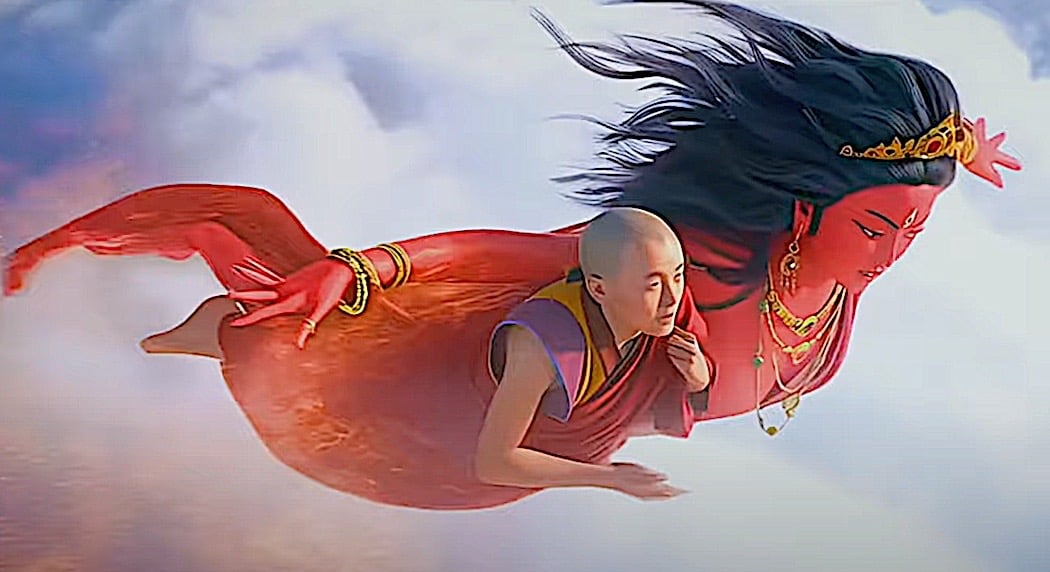
Of all the Vajrayana meditative deities, Vajrayogini, perhaps better known as Vajravarahi, is credited with being the one practice for our busy, hectic, terrifying times which can lead us, in one lifetime, to Enlightenment.
Video version of this feature:
How is that possible?
Simply put, Vajravarahi’s visualization, her appearance, her mantra, her sadhana, are all designed to counter our modern obstacles — especially the obstacles of our degenerate times which are so focused on greed, attachment, clinging and ego. Her shining red color symbolizes her power over attachment.
Her dancing or standing form, a dynamic pose, symbolizes that her practice is all about activity and getting into our daily lives.

Vajrayogini Practice in Modern Times
In our modern age, when we have no time, when life is always in the way of practice, when we struggle with many fears — terrorism, global warming, wars, paying the bills, healing our sickness — these are all the reasons to consider her practice.
Vajrayogini or Vajravarahi manifests in her fiery red, passionate, stunning beautiful and energetic form. Fast action. Fast practice. An appearance that is instantly modern and relatable.
This is one reason why Lama Yeshe, and many modern teachers recommended Vajravarahi or Vajrayogini.
On the one hand, she is more accessible to modern busy lives. When we dive deep into her practice, we find our teacher’s guide us with 11 yogas which incorporate her practice right into our daily, modern lives. With Vajravarahi and Vajrayogini we have no need to retreat to a cave for years.
Dont’ miss the 3Gems Band full 8 Lines of Praise with English praise and all 8 mantras in Sanskrit!:
This is illustrated in the 3 Gems Band song, linked at the information icon, with the second verse mentioning the monk Kushali. In the ancient story, Kushali was a novice monk who felt pity for an old woman with leprosy that his own master had ignored on the side of the road. He carried the old lady on his back, and was instantly rewarded when she transformed into glorious Vajravarahi. The goddess carried him to Kechara Pureland, her paradise, where he attained realizations.
Ordinary Generous Acts are Her Practice
This illustrates that ordinary, generous acts of merit and kindness are her daily practice, one of her yogas. Although the practice does require a teacher, empowerment and training, we can practice her praises and her acts of kindness now, in our every day lives, just as Kushali showed us. Vajravarahi is sure to notice.
Fortunately, some teachers, such as His Eminence Garchen Rinpoche, offer the Vajrayogini empowerment online with their blessing — which we have linked at the information icon. By attending the empowerment online, you draw closer to her practices.
Playlist for online Empowerment for those interested, with His Eminence Garchen Rinpoche:
For now, until we receive that wonderful empowerment, we can bring Vajravarahi Vajrayogini energy, activity and wisdom into our lives by praising her attributes with her 8 Lines of Praise or with her mantras. We can dedicate the merit of our praises and mantras to the future opportunity for empowerment.
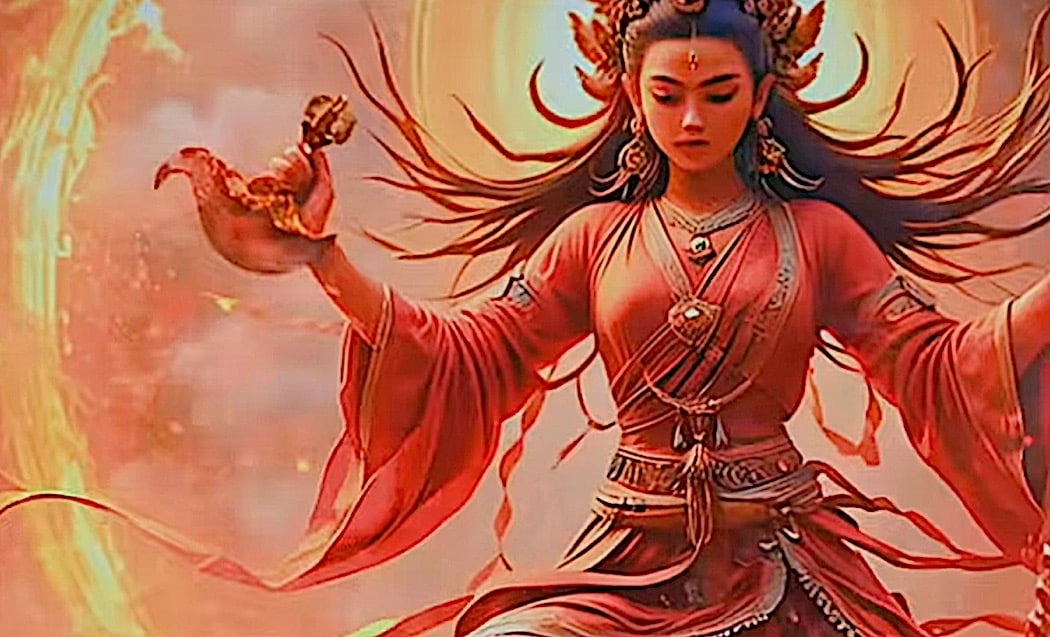
In the chanted praise sung by 3 Gems Band, which is musically chanted in English first, followed by Sanskrit, they sing the entire eight lines plus the mantra at the linked video.
At the end of this presentation we have only the Vajravarahi mantra. This praise and mantra is a meritorious daily practice, especially if you dedicate the merit to benefit of all beings and also to the opportunity for you, yourself to practice Vajravarahi or Vajrayogini. Bookmark the 3 Gems Band video with the praise for daily practice.

Vajravarahi Praise Mantra
Her main mantra which is repeated many times throughout the praise, and which we present 27 times at the end of this video, is:
oṃ namo bhagavati vajravārāhi vaṃ huṃ huṃ phaṭ
This more or less translates as:
Praise to Bhagavati Vajravarahi, please cut the obstacles to Enlightenment with your great essence “Vam”.
Vam is the seed syllable or essence syllable for Vajravarahi or Vajrayogini. In Tibetan this is phonetically Bam but in Sanskrit Vam.
The second line of praise is:
oṃ nama āryaparājite trailokyamāte mahāvidyeśvari huṃ huṃ phaṭ
This translates as: “I prostrate to you, Exalted Lady, queen of Wisdom, invincible in the three realms, please cut the obstacles to Enlightenment.”
The third line of praise is:
oṃ namaḥ sarvabhūtabhayāvahe mahāvajre huṃ huṃ phaṭ
This means: “I prostrate to you who destroy all evil spirits with your great vajra, please cut obstacles to Enlightenment.”
The fourth line of praise is:
oṃ namo vajrāsane ajite’parājite vaśaṃkari netrabhrāmiṇi huṃ huṃ phaṭ
This translates as: “I prostrate to You who are invincible, with overpowering eyes. Please cut the obstacles to Enlightenment.”
The fifth line of praise is:
oṃ namaḥ śhoṣaṇi roṣhaṇi krodhani karālini huṃ huṃ phaṭ
This more or less means: “I prostrate to your wrathful form, who reveals all illusions and cuts the obstacles to Enlightenment.”
The sixth line of praise is:
oṃ namaḥ saṃtrāsani māraṇi suprabhedani parājaye huṃ huṃ phaṭ
This means: “I prostrate to You who conquers all opponents by terrifying and desiccating demons and by cutting the obstacles to Enlightenment.”
The seventh line of praise is:
oṃ namo jaye vijaye jambhani mohani huṃ huṃ phaṭ
This translates as “I prostrate to You who vanquish all those that stupefy, paralyze, and confuse us.”
The final, or eighth line of praise is:
oṃ namo vajravārāhi mahāyogini kāmeśhvari khage huṃ huṃ phaṭ
This more or less means:
“I prostrate to Vajravarahi, the great yogini, dakini-queen of desire who cuts the obstacles to Enlightenment.”
Listen now (inset video above) as the 3 Gems Band chants Vajravarahi’s Praise mantra.
- Don’t miss the other great mantras, praises and sutras chanted by the amazing @3GemsBand on Youtube and from your favorite music streaming service.
4 thoughts on “Why is Vajravarahi Practice so Powerful? Vajravarahi Vajrayogini Practice and Mantra: Practicing Buddhist Wisdom and Method Without Renouncing the Worldly”
Leave a Comment
More articles by this author

Daśacakra Kiṣitigarbha Dhāraṇī: Rescuing All Beings: The Sanskrit Dharani that Saves Beings on Hearing or Seeing or Chanting
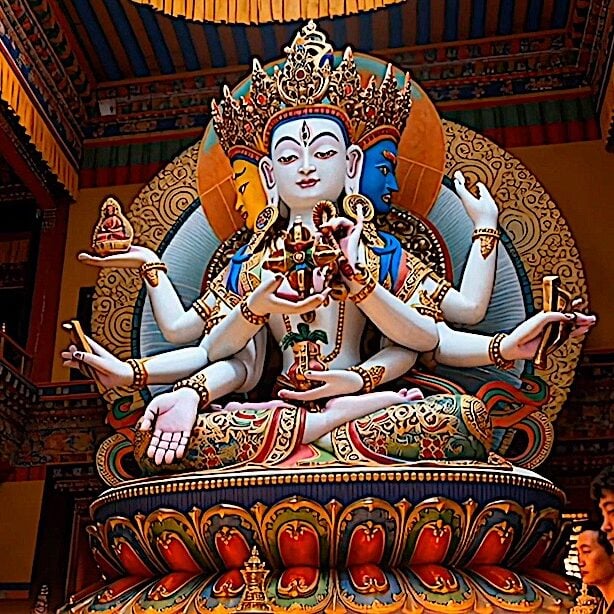
ON HEARING: Ushnisha Vijaya Dharani Overcomes Six Types of Suffering, Conquering the Lord of Death: Supreme in Six Realms

Sitatapatra or Dukkar — the ultimate protective Bodhisattva Goddess, form of Mother Tara — 1000 arms or 2 arms, she is “Aparajita” the Undefeatable One
Search
Latest Features
Please support the "Spread the Dharma" mission as one of our heroic Dharma Supporting Members, or with a one-time donation.
Please Help Support the “Spread the Dharma” Mission!

Be a part of the noble mission as a supporting member or a patron, or a volunteer contributor of content.
The power of Dharma to help sentient beings, in part, lies in ensuring access to Buddha’s precious Dharma — the mission of Buddha Weekly. We can’t do it without you!
A non-profit association since 2007, Buddha Weekly published many feature articles, videos, and, podcasts. Please consider supporting the mission to preserve and “Spread the Dharma." Your support as either a patron or a supporting member helps defray the high costs of producing quality Dharma content. Thank you! Learn more here, or become one of our super karma heroes on Patreon.
Lee Kane
Author | Buddha Weekly
Lee Kane is the editor of Buddha Weekly, since 2007. His main focuses as a writer are mindfulness techniques, meditation, Dharma and Sutra commentaries, Buddhist practices, international perspectives and traditions, Vajrayana, Mahayana, Zen. He also covers various events.
Lee also contributes as a writer to various other online magazines and blogs.

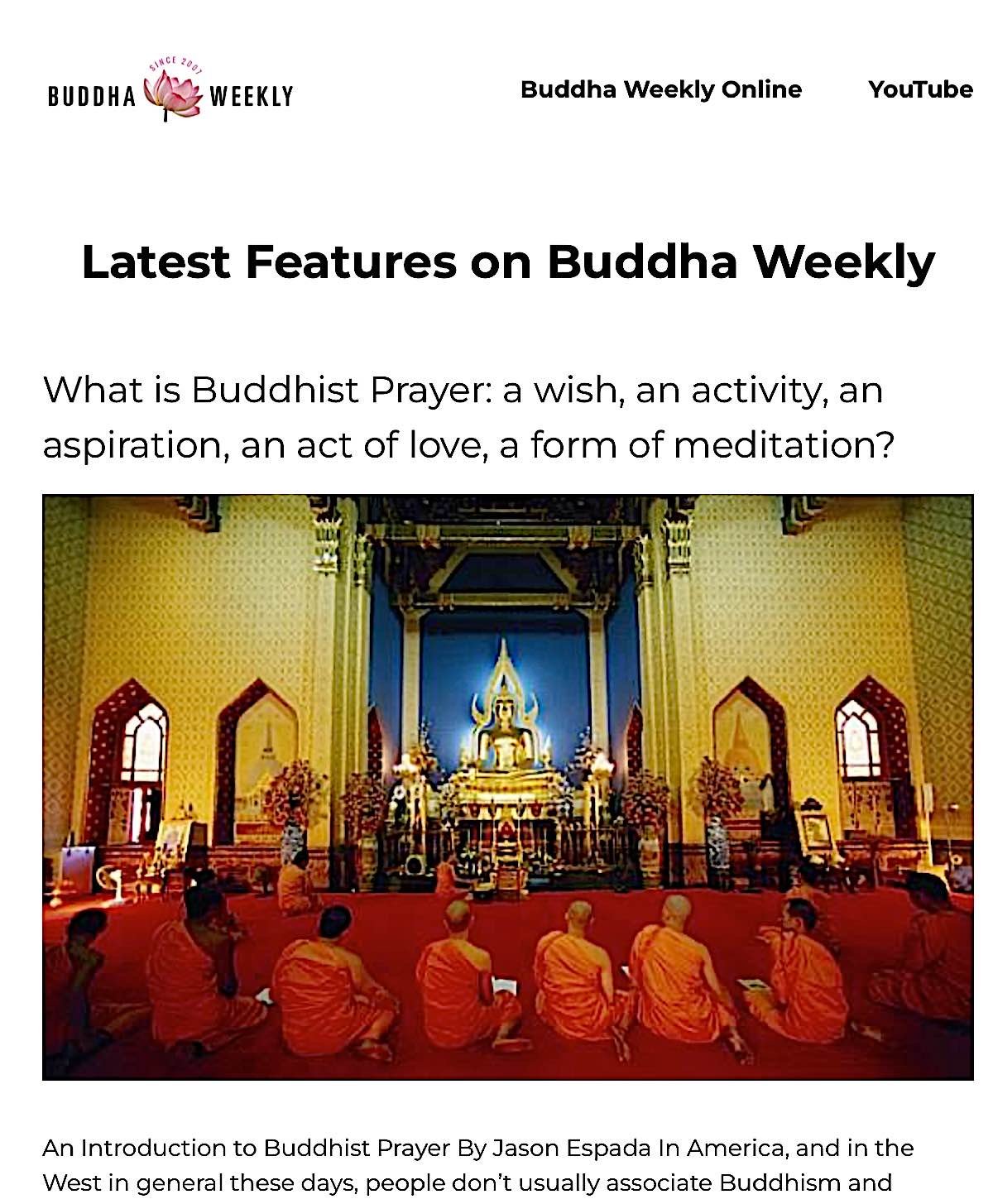


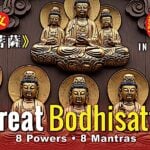











Thank you so much for sharing this wonderful article! I feel deeply inspired by the way it explains Vajravarahi / Vajrayogini practice as especially powerful — not as something distant, but as a path that can live in our everyday actions.
A few lines really stood out:
The idea that her practice transforms delusions, with more power when our obstacles are stronger — that gives hope and courage in hard times.
How ordinary acts of kindness and generosity are part of the yoga. Even simple, compassionate actions matter.
The way the method is accessible: no retreat to a cave needed — this makes the practice feel possible for people with busy lives.
I feel grateful that the Dharma shows not just the goal, but also how to live it in the midst of life. This enriches both aspiration and daily conduct. Thank you for this post.
Regards,
Antique Buddhas
https://www.antique-buddhas.com
I have taken the empowerment offered by Grachen Rinpoche in his video and started to recitate the 8 lines mantra daily, but what else can I do to practice Vajravarahi in daily life? Is there any written or video instruction on her every day practice or an easy to realize sadhana of her available here or elsewhere?
Dear Ed, First of all, congratulations. If you are planning to pratice as your Yidam, you’ll want to have commentary and instruction as well as empowerment. Garchen Rinpoche did have a number of videos on Youtube with past commentaries. If you haven’t already listened to the commentaries, I’d strongly suggest you do so. You can’t practice Sadhana without commentary guidance, really — you can certainly do puja and offering without.
Sadhanas (as opposed to Pujas) are mediative practice texts, basically, and the majority of Vajrayogini or Vajravarahi sadhanas have the 11 yogas as part of the practice (although the sleep, nectar, etc are not necessarily stated — they are meditations covered in commentary. If you have an opportunity try to find commentary on the 6 Yogas of Naropa and the 11 Yogas Vajrayogini. Those 11 yogas are basically all of our activities in daily life transformed into practce — sleep and dream, rising, nectar (breakfast, where your breakfast becomes an offering) and so on. Anyway, too long to go into hear, look for commetary, and better yet, keep an eye out for future events with commentary.
NEXT, have you taken refuge with Garchen Rinpoche formally? IF not, and assuming you take Garchen Rinpoche as your guru, that might be a best step to do. On their website, they walk you through the Refuge ceremony. For instance, you can take vows online: https://garchen.net/taking-vows-online/
They have a huge library of sources on their website: (And I do mean huge): https://garchen.net/resources-2/
Sadhanas are here: https://garchen.net/library-sadhanas-and-sacred-texts/
Anything they don’t have there, you probably have to ask for.
Please remember Sadhanas — unlike Pujas which are basically praising and making offerings for merit — are full practices requiring empowerment and perlmission.
For book resources, there are several (usually restricted labels, meaning, you need empowerment, although obviously it’s an “honor system” with publishers) and they are probably different lineages from Garchen Rinpoche’s — for example:The Extremely Secret Dakini of Naropa: Vajrayogini Practice and Commentary (The Dechen Ling Practice Series) (This, however is Sakya, Gellug lineage via Naropa, so probably not the same practice, it’s a highest Yoga Tantra which usually requires two initiations (Chakrasamvara and Vajrayogini) https://amzn.to/4o9LK6D
There are others, but they’re all different lineages. It’s best to practice with the lineage instructions of the teacher who gave you the Empowerment.
However, for PUJA practices — making daily offerings, Bodhichitta, Refuge, chanting the mantras — those all accumulate merit and are much more open.
I’d strongly suggest reaching out to Garchen Institute — Take on the Online Refuge as well, although that would have been part of the online empowerment, no doubt) — and explain that you took empowerment online, and would like to receive the Sadhana.
They’ll guide you from there. Hope that helps. In kindness, BW